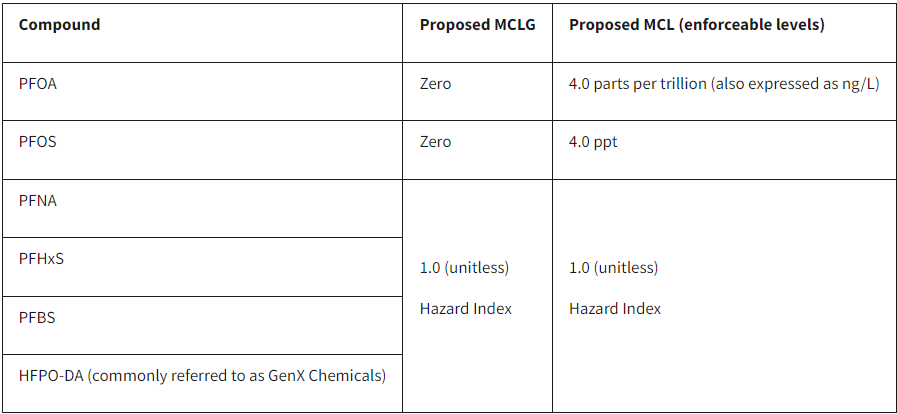EPA’s Proposed Regulation Regarding PFAS in National Drinking Water
Recently the United States Environmental Protection Agency (“EPA”) proposed its National Primary Drinking Water Regulation[1] (“NPDWR”) for six specific Per-and Polyfluroalkyl Substances (“PFAS”). The NPDWR will establish legally enforceable Maximum Contaminant Levels (“MCLs”), for six PFAS in drinking water, namely Perfluorooctanoic acid (“PFOA”) and Perfluorooctane sulfonic acid (“PFOS”) as individual contaminants and GenX Chemicals as a PFAS mixture. The proposed regulation, expected to be finalized later this year, would require public water systems to monitor for these PFAS, notify the public of the levels of these PFAS and reduce the levels of these PFAS in drinking water if they exceed the proposed standards.
The regulation would require every municipal water system in the country to test for, and if appropriate, limit the presence of six PFAS chemicals. Environmental consultants estimate that such tests may cost in the $400 to $500 range.
The proposed regulations would limit the two most common PFAS chemicals — PFOA and PFOS — to four parts per trillion in drinking water, close to the lowest level at which the chemicals can be detected. This level is also lower than any state set level. In addition, the EPA has proposed Maximum Contaminant Level Goals (“MCLG”) for PFOA and PFOS at zero.
The EPA is also proposing a standard for four other PFAS chemicals — PFHxS, PFBS, PFNA, and GenX — in drinking water. The proposal would regulate the cumulative mixture of these chemicals to keep them below a level considered dangerous to human health.
The EPA proposes that ground water systems serving more than 10,000 people and all surface water systems will test for the above PFAS quarterly while smaller groundwater systems will have to monitor twice a year with at least 90 days between tests.
Recently, the National Science and Technology Council announced that the White House Office of Science and Technology Policy (OSTP) released a state of science report on PFAS. The report focuses on the current science of PFAS as a chemical class, identifies scientific consensus, and portrays uncertainties in the scientific information where consensus is still sought. This report explains some of the potential problems of PFAS while also pointing out research data gaps that will be used for research and development of the Federal Government’s PFA strategy.
Impact of PFAS Regulations
Water users of all types – domestic household, municipal or industrial, agricultural – are all impacted by contaminated water supplies. Water quality standards vary for the intended use of the water, whether it be for drinking water or irrigating crops. Even though the PFAS contamination issues typically originate with groundwater supplies, diminished reliance on groundwater could increase the need for surface water supplies, which places further strain on the water rights and water supply systems. As such, water quality and water rights are inextricably intertwined with surface water and groundwater.
The EPA is using its resources under various programs to effectuate its PFAS Strategic Roadmap. The projected costs to water suppliers and industry are expected to be significant. In December 2021 the Infrastructure Investment and Jobs Act included $10 billion to address PFAS in drinking water. On February 13, 2023, the administration announced the availability of $2 Billion in Bipartisan Infrastructure Law Funding to States and Territories to Address Emerging Contaminants like PFAS in Drinking Water.
The OSTP state of science report on PFAS explains the current level of understanding and gaps of information. Although the NPDWR is a proposed regulation, the EPA has indicated it intends to set a PFAS standard before the end of the year.
The EPA will be holding its last informational webinar about the proposed PFAS NDPWR on March 29, 2023. EPA will also hold a public hearing on May 4, 2023, where members of the public can register to attend and provide verbal comments to EPA on the rule proposal. Registration is required to attend and the last day to register to speak at the hearing is April 28, 2023.
For further information regarding PFAS, please reference our PFAS overview article, or contact your AALRR attorney or the authors of this Alert.
[1] The EPA issued its PFAS Strategic Roadmap: EPA’s Commitments to Action 2021-2024 stating goals, objectives and key actions for setting standards and regulations for PFAS. This NPDWR is part of the EPA’s Strategic Roadmap.
This AALRR publication is intended for informational purposes only and should not be relied upon in reaching a conclusion in a particular area of law. Applicability of the legal principles discussed may differ substantially in individual situations. Receipt of this or any other AALRR publication does not create an attorney-client relationship. The Firm is not responsible for inadvertent errors that may occur in the publishing process.
© 2023 Atkinson, Andelson, Loya, Ruud & Romo
Attorneys
 Partner562-653-3200
Partner562-653-3200 Partner949-453-4260
Partner949-453-4260

